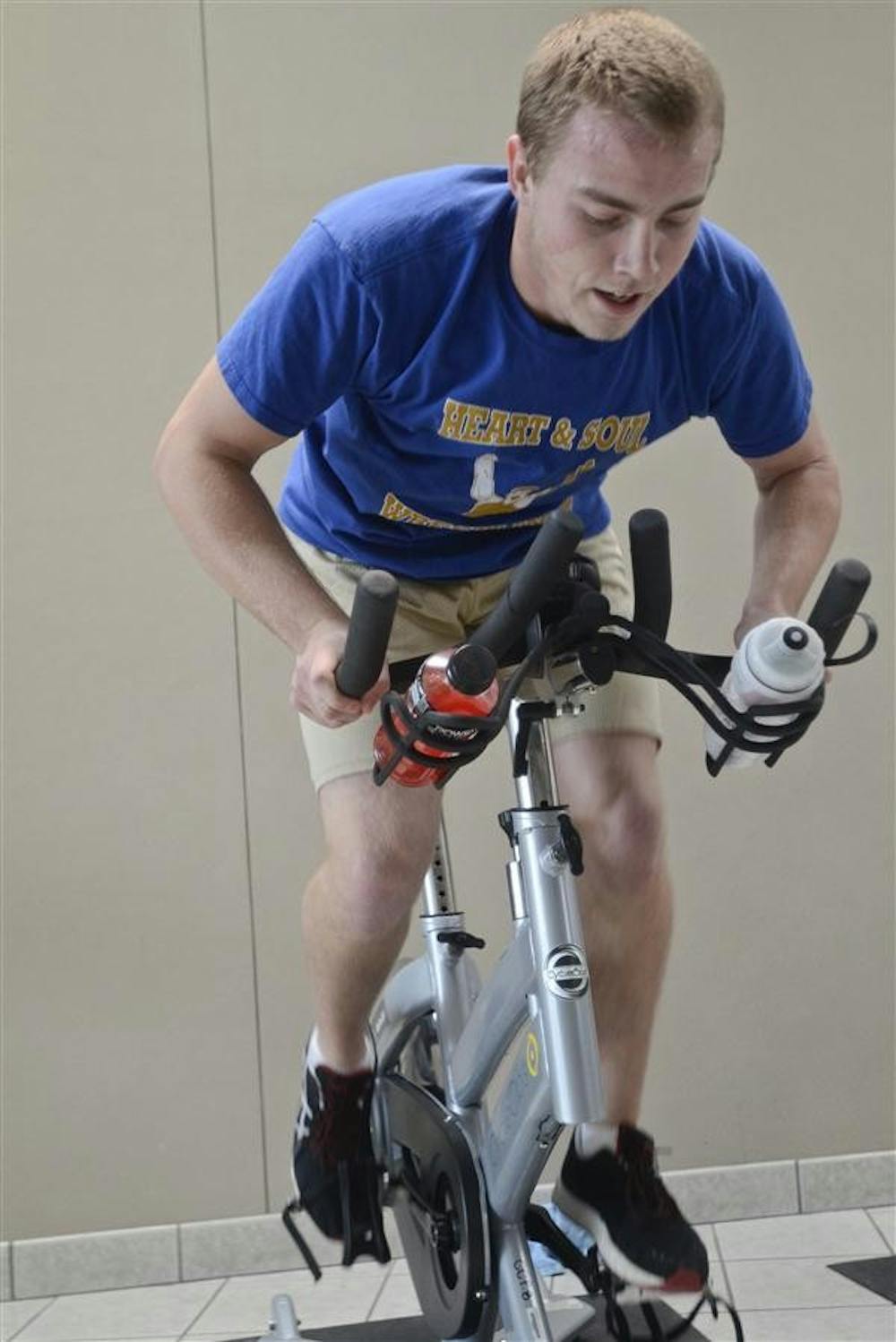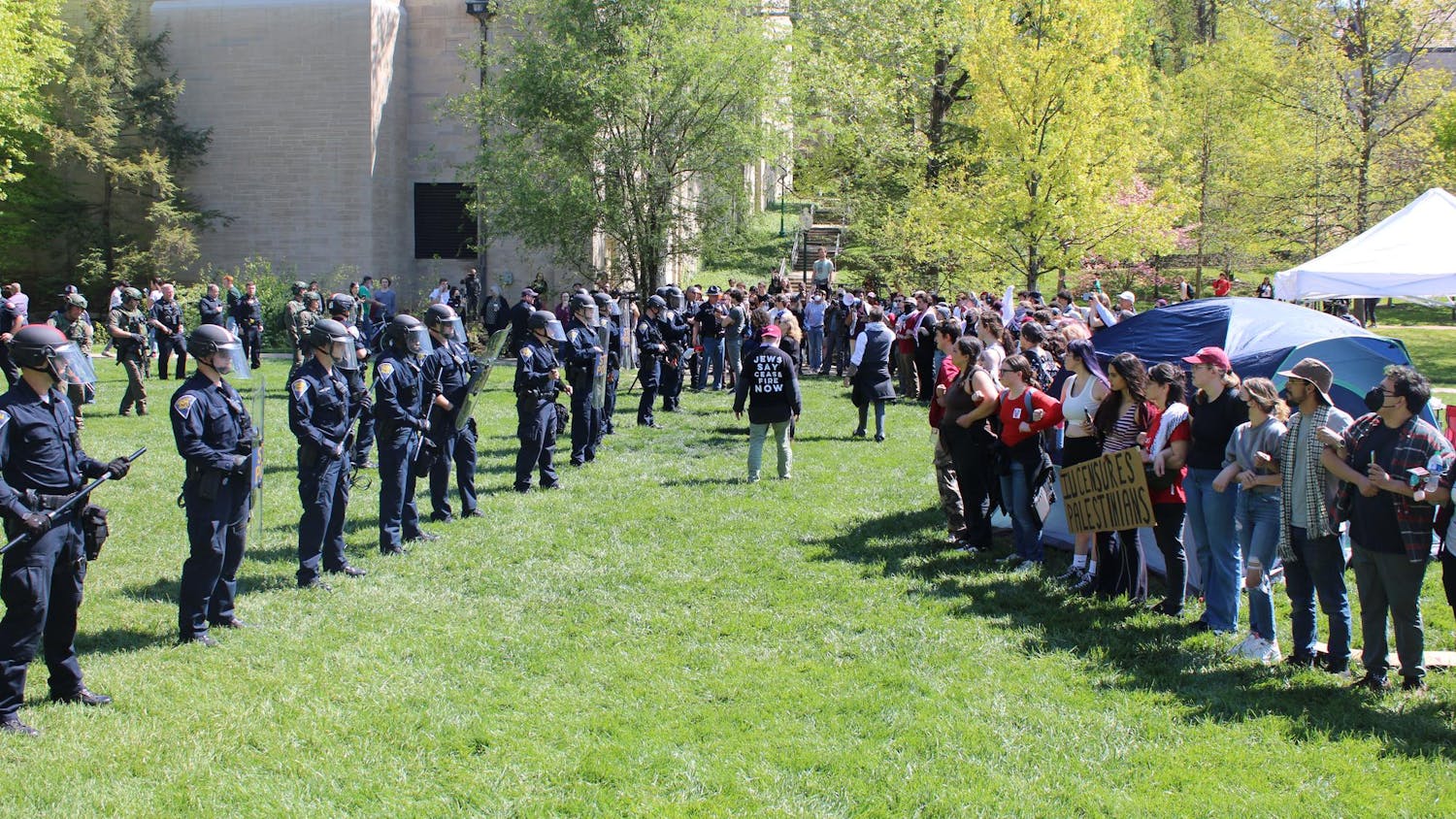Eleven Little 500 men’s teams and eight women’s teams competed and converted the mechanical energy they produced into electricity Saturday at the Student Recreational Sports Center.
Teams cycled in the Bike to Power the Student Recreational Sports Center event from 11 a.m. to 8:30 p.m.
This event was made possible through three PlugOut cycling bikes. One typical workout on the bike has the potential to power a cell phone for a week, according to the PlugOut website. The bikes have the ability to produce anywhere from 50 to 250 watts of energy in just one workout. In 18 minutes, each team produced an average of 180 watts.
The IU Student Association purchased three PlugOut bikes to add to the SRSC facility, as they had originally proposed in their campaign last spring. Last summer, IUSA Sustainability Director Ellen Spurgeon began collaborating and researching with Chris Arvin, Campus Recreational Sports program director for fitness and wellness.
“We spent several months this summer working with IUSA to evaluate the technology that is out there,” Arvin said. “We talked to our colleagues from other schools who have used this equipment. We learned what they’ve learned, discovered and what has worked best for them.”
Campus Recreational Sports will have the responsibility to provide maintenance and document IU students’ feedback about the new sustainable bikes. If the feedback is positive, the goal of IUSA, the IU Student Foundation and Campus Recreational Sports will be to incorporate and replace the current Cyclefit bikes with PlugOut ones.
“We estimate that if we replace every Cyclefit with these PlugOut bikes, we will be the largest and most sustainable sports center in the country,” IUSA Treasurer Kyle Straub said.
The Little 500 teams were each given a 20 minute warm-up time on CycleOps, a bike that measures watt output. They then had one minute to dismount, move to the PlugOut bikes and adjust them. Following this start-up period, the four team members could begin pedaling.
Three of the four riders kept their momentum going by riding the PlugOut bikes while their fourth team member raced their part of the 18-minute period. The members then switched until all four had ridden the CycleOps bike. The goal was to produce as much energy, measured in watts, as possible.
Spurgeon, fellow IUSA, IUSF and Campus Recreational Sports staff arrived at 7:45 a.m. to begin setup for the event. Four hours later, members began a drumroll as the team from Collins Center kicked off the event.
“When we were brainstorming ideas on how to demonstrate these bikes to a large campus audience, we came up with a demo idea for the Little 500 riders,” Spurgeon said.
People entering and exiting the SRSC stopped to watch the event. Their attention had been captured by the teammates yelling words of encouragement to one another.
Many observers pulled out their phones to take pictures and video of the bikers and their current standings in the competition. One observer, however, using a tripod and video camera, was there for a specific purpose.
The woman wielding the tripod was senior Laura Caldie. She is in the Individualized Major Program for environmental documentary.
“Sustainability is really becoming the forefront for student discussion here at IU, so I thought it would be really relevant to do my senior thesis project about IU and the different sustainability efforts that are going on,” Caldie said. “Since the Little 500 is something that impacts everyone here, that is a really central thing that I can focus on. I fully support putting that energy to use.”
The Little 500 teams spent their prep time reviewing tactics, stretching, socializing and talking about the new concepts of the PlugOut bikes. Teter Cycling took the No. 1 place for the women by producing a total of 261 watts during their 20-minute session.
“I’ve never had a wattage reader or even a computer on my bike, so it’s cool to see your results while you are working out,” Teter cyclist Lisa Hutcheson said. “We all agree that we would definitely use them if more were brought in.”
IUSA member Trevor Crafts documented the amount of power each team produced. The results showed the event had been a success in supporting the IUSA’s and IUSF’s initiative to “convert human generated energy into sustainable power.”
“The energy was flowing directly back into the SRSC’s power grid,” Crafts said. “As the CycleOps power ratings show, Little 500 riders are capable of producing 300-plus watts during intense training sessions.”
The next step for the PlugOut bikes will be to make them available to IU students and to obtain students’ opinions of the product. Staff members of Campus Recreational Sports, IUSA and IUSF hope to see a positive reaction to the bikes and their
sustainability.
“The teachable moment is how much work it really takes to put out significant electricity,” Arvin said. “So we are hoping that in turn it teaches lessons about
conservation.”
Little 500 teams compete, convert energy at SRSC

Get stories like this in your inbox
Subscribe





